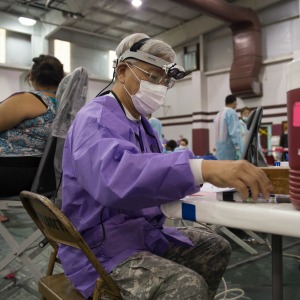Texas Guard, reservists and civilian partner at Operation Lone Star
Story by: Capt. Martha Nigrelle
Posted: July 28, 2016
 Lt. Col. John Hsu, a dentist in the 804th Medical Brigade, U.S. Army Reserves, Operations Chief for Dental Services, prepares to treat a patient at an Operation Lone Star site in Pharr, Texas, July 27, 2016. Service members from the Texas State Guard worked alongside Soldiers from the 804th Medical Brigade, U.S. Army Reserves, the Texas Department of Public Safety, the Department of State Health Services, Remote Area Medical volunteers, Cameron County Department of Health and Human Services (DHHS), City of Laredo Health Department, Hidalgo County DHHS and U.S. Public Health Services during Operation Lone Star (OLS), a week long real-time, large-scale emergency preparedness exercise in La Joya, Pharr, Brownsville, Rio Grande City and Laredo, Texas, July 25-29, 2016. OLS is an annual medical disaster preparedness training exercise, uniting federal, state and local health and human service providers, that addresses the medical needs of thousands of underserved Texas residents every year. (U.S. Army National Guard photo by Sgt. 1st Class Malcolm McClendon)
Lt. Col. John Hsu, a dentist in the 804th Medical Brigade, U.S. Army Reserves, Operations Chief for Dental Services, prepares to treat a patient at an Operation Lone Star site in Pharr, Texas, July 27, 2016. Service members from the Texas State Guard worked alongside Soldiers from the 804th Medical Brigade, U.S. Army Reserves, the Texas Department of Public Safety, the Department of State Health Services, Remote Area Medical volunteers, Cameron County Department of Health and Human Services (DHHS), City of Laredo Health Department, Hidalgo County DHHS and U.S. Public Health Services during Operation Lone Star (OLS), a week long real-time, large-scale emergency preparedness exercise in La Joya, Pharr, Brownsville, Rio Grande City and Laredo, Texas, July 25-29, 2016. OLS is an annual medical disaster preparedness training exercise, uniting federal, state and local health and human service providers, that addresses the medical needs of thousands of underserved Texas residents every year. (U.S. Army National Guard photo by Sgt. 1st Class Malcolm McClendon)
BROWNSVILLE, Texas -- Texas Guardsmen and U.S. Army Reservists worked alongside civilian partner agencies to provide necessary medical care to underserved Texas residents during Operation Lone Star, July 25-29, 2016 in La Joya, Pharr, Brownsville, Rio Grande City and Laredo.
Operation Lone Star is a large-scale emergency preparedness exercise that unites local, state and federal medical service and disaster response agencies.
“The hands on training has been great,” said Capt. Edith Cardwell, 804th Medical Brigade, U.S. Army Reserves. “Most of our training is notional. Here we have real-live patients instead of mannequins.”
Medical sites were set up in local schools providing immunizations, hearing and vision examinations, sports physicals, diabetic screening, blood pressure screening, dental services and behavioral health services.
The exercise first began in 1998, following an outbreak of tuberculosis in the Rio Grande Valley. Over the years, it has grown into one of the largest disaster preparedness exercises of its kind, in the country. As well as, providing annual training to disaster response agencies, Operation Lone Star ensures that thousands of Texas residents receive medical services, they may not receive otherwise.
“We are creating a ring of public health safety,” said Eduardo Olivarez, chief administrative officer for the Hidalgo County Department of Health and Human Services. “Because of this training, we are prepared for any future outbreaks. We know exactly how long it will take us to immunize a large number of people and what resources we will need to do that.”
For the first time, more than 100 soldiers from the 804th Medical Brigade joined experienced medical providers from the Texas Military Department, the Department of Public Safety, Department of State Health Services, Remote Area Medical, Cameron County Department of Health and Human Services, City of Laredo Health Department, Hidalgo County Department of Health and Human Services and the U.S. Public Health Services.
They weren’t the only ones new to the team. The inaugural class of the University of Texas – Rio Grande Valley medical school volunteered their time to assist patients, physicians and administrative specialists with the operation.
On only their third day of medical school, the students arrived at Operation Lone Star, ready to learn.
“They teach us the ‘see one, do one, teach one’ model,” said Sonya Rivera, one of the students. “So that’s what we are doing here.”
This year the students are observing and helping wherever they can, said Rivera. Each year, as they learn more, they hope to be able to ‘do one’ and provide hands-on medical care. Eventually, their goal is to be able to teach others.
“If you can do that, then you have mastered it,” said Rivera.
Side by side, Guardsmen worked with Reservists, civilian medical experts and students, a seemingly well-oiled team, after only a few days.
In the past three years, there were 119,683 services given at Operation Lone Star providing approximately $12 million of support to Texas residents in the Rio Grande Valley said Maj. Gen. Jake Betty, commanding general of the Texas State Guard.
“If a disaster ever occurs, it’s great to meet our colleagues in this environment; we can learn a lot from each other.” said Col. Jonathan MacClements, a physician in the Texas State Guard. “We are all on the same team.”
Texas Army National Guard Capt. Jessica Jackson contributed to this article.